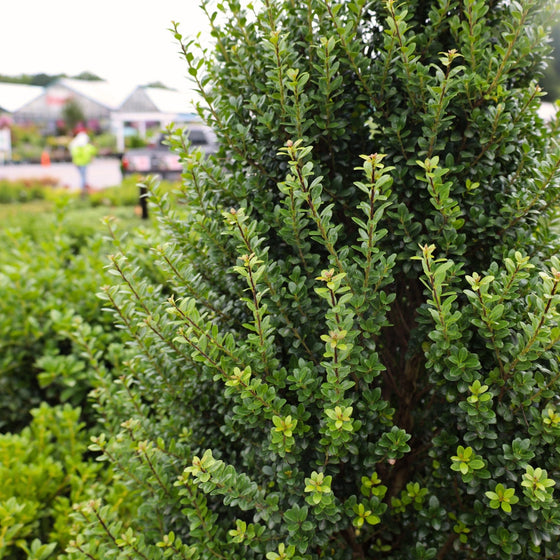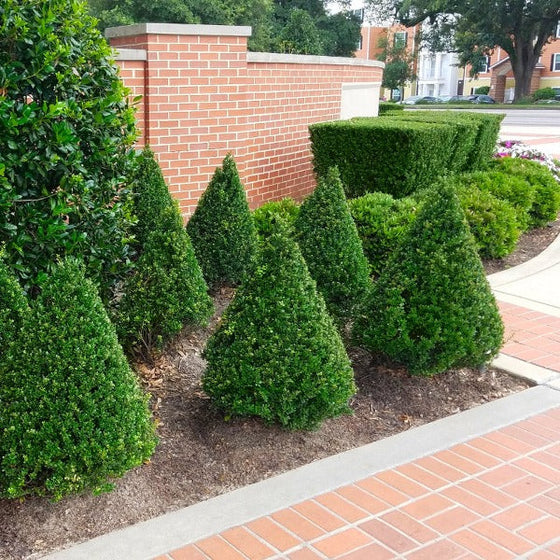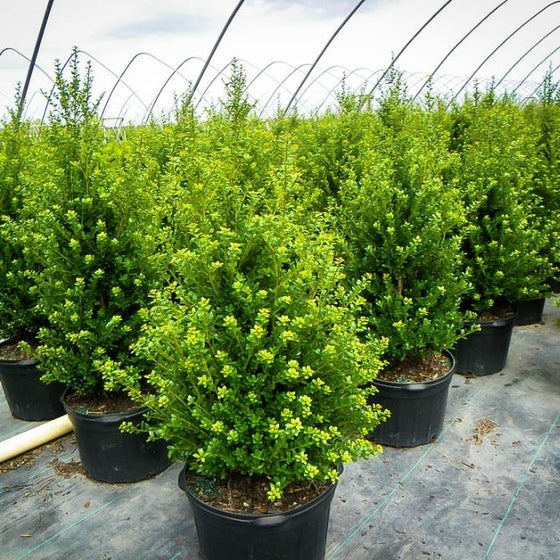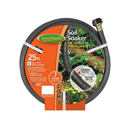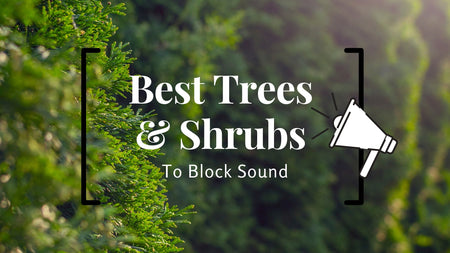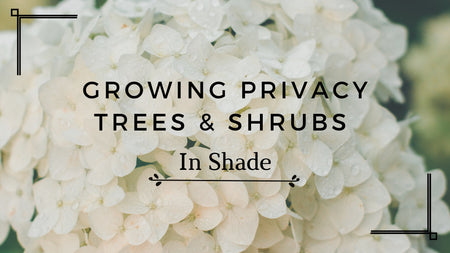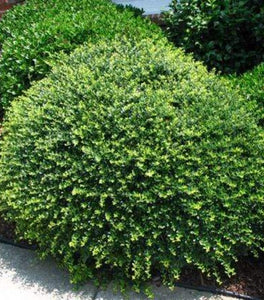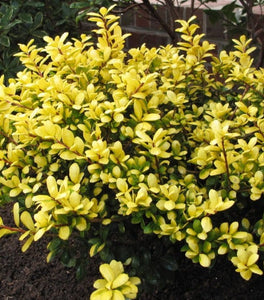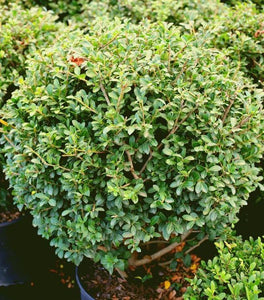
Images Depict Mature Plants
Steeds Holly Shrubs for Sale Online
Steeds Holly (Ilex crenata 'Steeds') is a striking, dense, pyramidal evergreen shrub that adds elegance and structure to any landscape. Its dark green, glossy leaves remain vibrant throughout the year, making it an ideal choice for year-round interest. With a mature height of 6 to 8 feet and a spread of 3 to 4 feet, Steeds Holly is perfect for creating formal hedges, foundation plantings, or as a focal point in garden beds. This holly's naturally upright, pyramidal growth habit requires minimal pruning, making it an excellent low-maintenance option for both formal and informal landscapes.
Thriving in USDA zones 6-8, Steeds Holly is highly adaptable to various growing conditions, including full sun to partial shade, and can tolerate different soil types as long as they are well-drained. Small white flowers emerge in spring, adding a subtle yet charming detail to the shrub. These flowers give way to small black berries in the fall, providing additional seasonal interest and attracting birds to your garden. Steeds Holly's versatility makes it an excellent choice for adding structure, privacy, and vibrant color to outdoor spaces.
Steeds Holly is also deer-resistant, which makes it a reliable choice for gardens in areas prone to deer browsing. Its hardiness and classic beauty make this holly an ideal plant for creating privacy screens, defining garden borders, or using it as a stand-alone specimen. Whether used in a formal hedge or as part of a mixed planting, Steeds Holly offers timeless appeal and adds a lush, green backdrop that enhances the beauty of surrounding plants and flowers year-round.
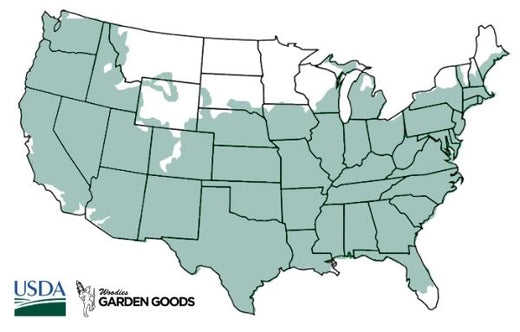
| Hardiness Zone: | 6-9 |
|---|---|
| Mature Height: | 6 to 8 Feet |
| Mature Width: | 3 to 4 Feet |
| Classification: | Broad leaved evergreen shrub |
| Sunlight: | Full sun to part sun |
| Habit: | Upright, pyramidal habit |
| Flower Color: | Inconspicuous, black berries |
| Foliage: | Dark green |
| Pruning Season: | Prune anytime |
| Soil Condition: | Any well drained slightly acidic soil |
| Water Requirement: | Water well until established |
| Uses: | Extremely attractive when used as a focal point in the mixed border, foundation planting, or a specimen planting |
How to Care for Steeds Holly
Before you buy an Steeds Holly, make sure to read our care instructions to keep this plant healthy and thriving.
How do I Plant Steeds Holly?
To plant Steeds Holly, start by selecting a location with well-drained soil and exposure to full sun or partial shade for optimal growth. Dig a hole twice as wide and as deep as the root ball to give the roots enough space to spread and establish. Place the shrub in the hole, making sure that the top of the root ball is level with the surrounding soil to ensure proper drainage. Backfill with a mixture of native soil and compost to enhance soil quality and nutrient content, then water thoroughly after planting to settle the soil and promote healthy root development. Adding a 2- to 3-inch layer of mulch around the base of the shrub will help retain moisture and regulate soil temperature while keeping the mulch a few inches away from the trunk to prevent rot. If you are planting multiple Steeds Hollies to create a hedge or privacy screen, space them about 3 to 4 feet apart, measuring from the center of each plant. This spacing allows the shrubs to grow together and form a dense, lush barrier while providing adequate room for each plant to thrive. During the first growing season, water regularly to keep the soil consistently moist but not waterlogged, as this helps the root system become established. Steeds Holly adapts well to a range of soil types and can thrive in full sun to partial shade, making it a versatile option for many landscape applications. With proper planting and care, Steeds Holly will grow into a beautiful, structured, and low-maintenance addition to your garden.
How do I Water Steeds Holly?
To properly water Steeds Holly, focus on deep and consistent watering, especially during the first year after planting to establish a healthy root system. Water the shrub deeply once a week, ensuring the soil is moist down to a depth of 6 to 8 inches, which helps encourage deep root growth. During hot or dry periods, you may need to increase the watering frequency to keep the soil from drying out completely. It’s best to water Steeds Holly at the base of the plant, rather than overhead, to avoid wetting the foliage, which can lead to fungal issues. Mulching around the base of the shrub also helps retain moisture and regulate soil temperature, reducing the need for frequent watering. Once Steeds Holly is established, it becomes moderately drought-tolerant and requires less frequent watering. However, during prolonged dry spells or periods of extreme heat, occasional deep watering will help maintain the shrub’s lush, green foliage and overall health. Check the soil regularly by digging a few inches down—if it feels dry, it’s time to water. Avoid overwatering, as Steeds Holly prefers well-drained soil and can suffer from root rot if left in consistently soggy conditions. By following proper watering practices, your Steeds Holly will thrive, providing beautiful, year-round greenery and structure to your landscape.
How do I Fertilize Steeds Holly?
To fertilize Steeds Holly, apply a balanced, slow-release fertilizer in early spring just before new growth begins. A fertilizer with an N-P-K ratio of 10-10-10 is ideal for promoting healthy root development, vibrant foliage, and overall plant vigor. Spread the fertilizer evenly around the base of the shrub, but be careful not to place it too close to the trunk to avoid root burn. After applying the fertilizer, water the area thoroughly to help the nutrients absorb into the soil and reach the root system. This early feeding will ensure that Steeds Holly has all the nutrients it needs to support lush, green growth throughout the season. For ongoing health and robust growth, Steeds Holly can benefit from an additional light feeding in mid-summer, especially if the shrub is growing in poor soil. Organic compost or well-rotted manure can also be used to improve the soil quality and offer long-term benefits. Incorporating these organic materials helps enrich the soil and promotes healthy, steady growth. Regular fertilization not only encourages dense, glossy foliage but also enhances the plant’s resistance to pests and diseases. With proper feeding, Steeds Holly will thrive, providing a low-maintenance evergreen option that enhances your landscape with beautiful, year-round structure and color.

How do I Prune Steeds Holly?
To prune Steeds Holly, begin by performing light pruning in late winter or early spring, just before the new growth starts. Use sharp, clean pruning shears to remove any dead, damaged, or diseased branches, which improves airflow and promotes healthier growth throughout the shrub. Pruning at this time also allows you to shape the naturally pyramidal form of Steeds Holly, helping it maintain its structured appearance. When shaping, avoid cutting back more than one-third of the plant to prevent unnecessary stress, and focus on maintaining its classic, dense form that makes it ideal for formal hedges or as a focal point in the landscape. For ongoing maintenance, Steeds Holly may require some light touch-up pruning during the growing season to keep its shape neat and tidy. If you are growing Steeds Holly as a hedge, prune the outer growth to maintain the desired height and width, ensuring that sunlight can reach all parts of the shrub evenly. Avoid heavy pruning in late summer or fall, as this can stimulate new growth that might be damaged by winter frosts. Regular, minimal pruning encourages dense, lush foliage, allowing Steeds Holly to maintain its elegant, structured appearance while providing year-round interest in your garden.

